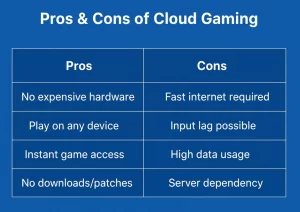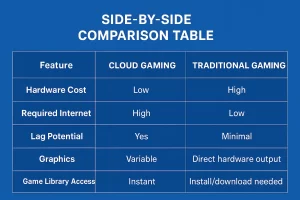Why Cloud Gaming Needs High-Speed Internet
Cloud gaming places far heavier demands on your connection than typical online activities. Unlike watching video, gaming is interactive—meaning your inputs must travel instantly to the server and back. Even a 50–100ms delay can ruin the experience. This is why high-speed internet isn’t optional; it’s the backbone of any smooth cloud gaming session.
Real-Time Streaming Requirements
Cloud gaming streams visually intensive content at rapid refresh rates—60fps, 120fps, and sometimes beyond. That means massive amounts of data need to move between you and the server. The higher the resolution, the more bandwidth required:
- 720p streaming: 5–10 Mbps
- 1080p streaming: 15–25 Mbps
- 4K streaming: 35–50+ Mbps
Without enough bandwidth, the stream will downgrade quality or freeze entirely.
Latency and Ping Explained
Latency (also called ping) is the time it takes for a signal to travel from your device to the server and back. For cloud gaming:
- Under 30ms = Excellent
- 30–60ms = Playable
- 60–120ms = Noticeable delay
- 120ms+ = Poor experience
Games like shooters, racing titles, and competitive esports absolutely require low latency to remain responsive.
Bandwidth Consumption
Cloud gaming easily consumes 5–20 GB per hour, depending on resolution. This heavy data usage puts pressure not only on your download speed but also on your internet provider’s infrastructure. As more gamers switch to cloud gaming, global bandwidth demand rises sharply.
Benefits of High-Speed Internet for Cloud Gaming
High-speed internet doesn’t just make cloud gaming possible—it makes it enjoyable. A fast connection unlocks the full potential of cloud platforms like GeForce NOW, Xbox Cloud Gaming, PlayStation Plus, and Amazon Luna.
Better Graphics & Resolution (1080p, 4K, 120fps)
Cloud gaming services offer incredibly high visual quality—sometimes better than consoles. With enough internet speed, players enjoy:
- Crisp 1080p or 4K visuals
- High framerates (60–120fps)
- Ray-tracing on compatible platforms
- Minimal compression artifacts
This creates a console-like experience without the bulky hardware.
Faster Response Times
High-speed internet reduces input lag, making movement and interactions feel instantaneous. Whether you’re firing a weapon, dodging attacks, or drifting around corners, fast internet ensures you stay competitive.
Smoother Multiplayer Gameplay
Multiplayer cloud games require both low latency and high bandwidth. Fast internet reduces lag spikes, keeps the session stable, and ensures that all players’ actions are synced in real time.
Main Benefits at a Glance
- Reduced lag
- Higher visual quality
- Enhanced responsiveness
- Fewer dropped connections
- Better competitive performance
Comparison Table: Low-Speed vs High-Speed Internet

Challenges: Problems Without Fast Internet
Not all gamers have access to high-speed internet. When speeds are too slow or unstable, cloud gaming can quickly become frustrating.
Input Lag
This is the most noticeable issue when the internet speed or stability drops. Inputs feel delayed, making fast-paced games nearly impossible to play.
Video Compression Artifacts
When bandwidth is low, cloud services reduce the video bitrate. This leads to:
- Blurry textures
- Pixelated motion
- Visual noise
It feels like watching a low-quality stream instead of playing a premium game.
Disconnections & Stuttering
Unstable networks can cause:
- Random game freezes
- Audio desync
- Forced resolution drops
- Complete session termination
Pros & Cons of Cloud Gaming

Cloud Gaming vs Traditional Gaming
How does cloud gaming compare to buying a console or gaming PC?
Comparison of Hardware Needs
Cloud gaming eliminates the need for:
- Graphics cards
- CPUs
- RAM upgrades
- Storage devices
A basic smartphone or laptop is enough.
Traditional gaming requires strong hardware but offers local performance with zero streaming issues.
Cost Differences
Cloud gaming:
- Monthly subscription fees
- No hardware upgrades
- No game downloads
Traditional gaming:
- High upfront hardware cost
- Ongoing upgrades
- Purchase of physical or digital games
Performance Differences
Cloud gaming performance depends on internet speed. Traditional gaming performance depends on hardware specs.
Side-by-Side Comparison Table

Best Practices for Cloud Gaming Performance
To get the best results, gamers should optimize their home network.
Minimum Internet Speeds for Cloud Gaming
- 1080p: 15–25 Mbps
- 4K: 35–50 Mbps
- Competitive play: Low latency under 30ms
Wi-Fi vs Ethernet: Which Is Better?
Ethernet:
- More stable
- Lower ping
- No interference
Wi-Fi:
- Convenient
- Speeds vary based on distance and obstacles
For cloud gaming: Ethernet is strongly recommended.
Router Optimization Tips
- Enable Quality of Service (QoS)
- Use 5GHz Wi-Fi for faster speeds
- Limit background devices
- Restart router weekly
- Update firmware regularly
Recommended Settings for Smooth Gameplay
- Turn off VPNs
- Close unnecessary apps
- Use direct HDMI display instead of wireless casting
- Lower resolution if the network becomes unstable
Common Myths About Cloud Gaming and Internet Speed
Myth: “You Don’t Need Fast Internet”
Cloud gaming requires significantly faster connections than streaming video. Without high-speed internet, the experience is poor.
Myth: “Any Wi-Fi Works”
Old routers, busy networks, and interference can destroy performance—even if your internet plan is fast.
Myth: “Cloud Gaming Will Replace Consoles Overnight”
Cloud gaming is growing fast, but hardware still matters. Internet infrastructures worldwide must improve before cloud gaming becomes the default.
How Internet Providers Are Responding
Cloud gaming’s rise pushes ISPs to upgrade infrastructure globally.
Fiber Expansion
Fiber optic internet provides the fastest speeds with the lowest latency. ISPs are rapidly expanding fiber networks to meet gaming demands.
5G Home Internet
5G offers speeds comparable to fiber in many cities, making it a strong alternative for cloud gaming—especially in areas with weak wired internet.
Data Caps & Fair Usage Policies
High data usage from cloud gaming is leading some ISPs to adjust data caps, though many gamers argue these limits are outdated.
Future of Cloud Gaming and High-Speed Internet
Growth of 5G & Edge Computing
Edge computing places servers closer to players, reducing latency and speeding up streaming. Combined with 5G, cloud gaming performance could approach local hardware quality.
AI-Powered Network Optimization
AI is being used by ISPs to manage congestion and automatically adjust streaming quality.
What Gamers Can Expect in the Next 5 Years
- Immersive 8K cloud gaming
- Near-instant input response
- Global fiber expansion
- More cloud-exclusive titles
FAQs
1. Why does cloud gaming need high-speed internet?
Cloud gaming streams interactive video in real time, requiring fast speeds and low latency to avoid lag and visual degradation.
2. How much speed do I need for cloud gaming?
For 1080p, at least 20 Mbps is recommended; for 4K, 35–50 Mbps ensures stable performance.
3. Is Wi-Fi good enough for cloud gaming?
Yes, but Ethernet is better. Wi-Fi can suffer from interference, causing lag and quality drops.
4. Does cloud gaming use a lot of data?
Yes. It can use between 5–20 GB per hour depending on resolution and framerate.
5. Will cloud gaming replace consoles?
Not yet. Internet infrastructure still needs improvement, and many gamers prefer local hardware.
Conclusion
Cloud gaming is reshaping the gaming world—and it’s doing it fast. As more people switch from consoles to streaming platforms, the demand for high-speed internet continues to rise. Faster networks, fiber expansion, and 5G innovation are all pushing cloud gaming into the mainstream. If you want the best cloud gaming experience, upgrading your internet connection and optimizing your home network is essential.




